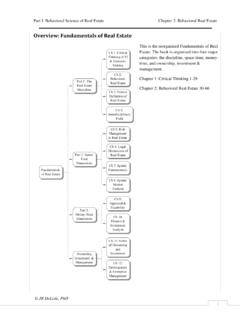Transcription of REAL ESTATE SECTOR IN INDIA - Assotech
1 real ESTATE SECTOR IN INDIA 1. INDIA S real ESTATE SECTOR Overview With around billion people, INDIA is the second most populous country after Chinaand it is expected to overtake it by 2030. Its economic transformation over the pastdecade has pushed up real GDP growth to an average of 6 per cent per annum since 1992. INDIA is emerging as an important business location, particularly in the services favourable demographics and strong economic growth make the country anattractive place for property investors, given that demand for property is determined chiefly by business development and demographic trends. Historically, the real ESTATE SECTOR in INDIA was unorganised and characterized by variousfactors that impeded organised dealing, such as the absence of a centralized title registry providing title guarantee, lack of uniformity in local laws and their application,non-availability of bank financing, high interest rates and transfer taxes, and the lack oftransparency in transaction values.
2 In recent years however, the real ESTATE SECTOR in INDIA has exhibited a trend towardsgreater organisation and transparency, accompanied by various regulatory reforms include: Government of INDIA support to the repeal of the Urban Land Ceiling Act, with nine state governments having already repealed the Act Modifications in the Rent Control Act to provide greater protection to homeowners wishing to rent out their properties Rationalization of property taxes in a number of states The proposed computerization of land records The trend towards greater organisation and transparency has contributed to thedevelopment of reliable indicators of value and the organised investment in the realestate SECTOR by domestic and international financial institutions, and has also resulted inthe greater availability of financing for real ESTATE developers. Regulatory changespermitting foreign investment are expected to further increase investment in the Indianreal ESTATE SECTOR .
3 The nature of demand is also changing, with heightened consumerexpectations that are influenced by higher disposable incomes, increased globalizationand the introduction of new real ESTATE products and services. Demand Drivers These trends have benefited from the substantial recent growth in the Indian economy, which has stimulated demand for land and developed real ESTATE across the real estateindustry. Demand for residential, commercial and retail real ESTATE is rising throughoutIndia, accompanied by increased demand for hotel accommodation and improvedinfrastructure. Additionally, the tax and other benefits applicable to Seas are expected to result in anew source of real ESTATE demand. Residential real ESTATE Development The growth in the residential real ESTATE market in INDIA has been largely driven by risingdisposable incomes, a rapidly growing middle class, low interest rates, fiscal incentiveson both interest and principal payments for housing loans, heightened customerexpectations, as well as increased urbanisation and growing number of nuclear families.
4 According to National Council of Applied Economic Research (NCAER), incomeclasses with annual incomes between Rs. 2 million and Rs. 5 million per year, Rs. 5million and Rs. 10 million per year, and in excess of Rs. 10 million per year are expectedto increase in size by 23 per cent, 25 per cent and 28 per cent, respectively, from fiscal2005 to fiscal 2010. These higher income households are expected to be the targetcustomers for the luxury and super luxury residential developments. The residential SECTOR is expected to continue to demonstrate robust growth over thenext five years, assisted by the rising penetration of housing finance and favourable taxincentives. Commercial real ESTATE Development The recent growth of the commercial real ESTATE SECTOR in INDIA has been fuelled byincreased revenues of companies in the services business, particularly in the IT andITES sectors. industry sources expect the IT and ITES sectors to continue to grow and generate additional employment, which they expect will result in increased demand forcommercial space.
5 Within the IT and ITES sectors, the Indian off shoring operations of multinationalcompanies are expected to increase demand for commercial space. The trend for thesecompanies has been to set up world class business centres to house their growing workforce. INDIA continues to lead the AT Kearney Offshore Location Attractiveness Indexby a significant margin. Retail real ESTATE Development The organised retail segment in INDIA is expected to grow at a rate of 25 per cent to 30per cent over the next five fiscal years. The growth of organised retail is expected to bedriven by demographic factors, increasing disposable incomes, changes in shoppinghabits, the entry of international retailers into the market and the growing number ofretail malls. The major organised retailers in INDIA currently include Tata-Trent, Pantaloon, Shopper s Stop and the RPG Group. While organised retail has so far been limited tolarger cities in the country, retailers have announced major expansion plans in smallercities and towns.
6 The growth of organised retail in INDIA will also be affected by thereported entry into the SECTOR of major business groups such as Reliance, Bennett &Coleman, Hindustan Lever, Hero Group and Bharti. International retailers such asMetro, Shoprite, Lifestyle and Dairy Farm International have already commencedoperations in the country. Hospitality industry The hotel industry in INDIA has grown as a result of a growing economy, increasedbusiness travel and tourism. Further, investments in the premium segment of the hotel industry are expected to bebetween Rs. 20 billion and Rs. 23 billion in the aggregate over the next five years. According to an industry report, the majority of segments in the Indian hotel industryhave shown robust recent growth in room rates as well as occupancy rates. Withincreased demand and limited availability of quality accommodation, the average roomrates in metropolitan markets have grown by approximately 50 per cent over the lasttwo years, the exceptions being Bangalore, where the rates have more than doubled,and Kolkata, where they have risen only marginally notwithstanding strong growth inoccupancy rates.
7 The general increase in room rates and occupancy rates is expected tocontribute significantly to the demand for new hotel developments. Special Economic Zones (SEZ) SEZs are specifically delineated duty free enclaves deemed to be foreign territories forpurposes of Indian custom controls, duties and tariffs. There are three main types ofSEZs: integrated SEZs, which may consist of a number of industries; services SEZs,which may operate across a range of defined services; and SECTOR specific SEZs, whichfocus on one particular industry line. Regulatory approvals have been received for SEZsproposed to be developed by a number of developers. SEZs, by virtue of their size, areexpected to be a significant new source of real ESTATE demand. Infrastructure Development Projects Central and state governments in INDIA are increasingly focused on infrastructure development. A significant portion of infrastructure development is expected to beundertaken through public-private partnerships, thereby increasing the flow of privatecapital into infrastructure projects.
8 Key areas of infrastructure development include transport, power, telecommunications, ports, pipelines, sanitation, water supply andirrigation. Applying this average to the biggest urban agglomeration areas in the country, it follows that in 2030 Mumbai will have a population of roughly 35 million and Kolkata andDelhi just under 30 million in 2030. This could still be considered a conservativeestimate as it puts urbanisation in INDIA then only at China s level today. Assuming that the growth of INDIA s industrial activity and high-end services grow at an above-average pace, the rural exodus could speed up sharply, similar to the development in China. There are two clear outcomes following from this. Firstly, INDIA s cities must gear upto a dramatic increase in size. Their infrastructure (schools, roads, airports, seaportsetc.) and housing capacities will need to expand massively. Secondly, the acceleratedrate in urbanisation throws into particularly sharp focus the possibility that establishedcentres ( Tier I cities) are already straining the limits of their capacities, leading to aboveaverage expansion in the second-tier cities.
9 The most important office locations are in the Central Business Districts (CBD). It has only been in the last few years, as space has become more limited in the CBDs andnew higher quality offices with lower prices have been built in peripheral locations thatdemand has shifted from downtown areas out to the new locations called Secondary Business Districts (SBD). Most recently, additional development areas, with amixture of office, retail and residential, have been built. Just like other global locations,the most important locational factors are the availability of staff, ease of access by car and public transport and regional growth potential. In Indian cities it is also importantto access the technical infrastructure provision ( electricity, telephones and watersupply) to ensure that it meets requirements. The most transparent and liquid office markets are that of Delhi, Mumbai andBangalore. It is worth noting, however, the enormous potential of the growing marketsin the Tier II and Tier III cities, such as Pune, Hyderabad or Chennai.
10 Growing Satellite Business Destinations With commercial space in the CBDs and SBDs in the metros getting saturated, thesurrounding non-metro areas are getting investor attentions. In northern part of thecountry, the business activities of Delhi NCR are getting extended to the adjoining areasof Rajasthan adjacent to Delhi NCR like Bhiwadi, Neemrana (in Alwar district) hasattracted a lot of domestic and foreign industrial investments. Similarly in SouthernIndia, the adjoining areas of Bangalore like Hosure district of Tamil Nadu haveprovided space for extension of the industrial areas. However, the Mumbai andChennai, by virtue of its geographical conditions of being surrounded by sea, faceconstraint in terms of expansion. Delhi NCR Delhi, INDIA s second biggest city is the seat of government and represents the central traffic hub in the north of INDIA . Delhi s office market extends beyond the metropolitan area to the neighbouring towns of Gurgaon in the south and Noida/Greater Noida in the east.






